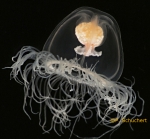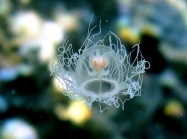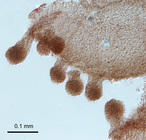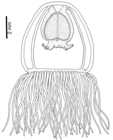NARMS taxon details
Oceania armata Kölliker, 1853
117437 (urn:lsid:marinespecies.org:taxname:117437)
accepted
Species
marine, fresh, terrestrial
recent only
Kölliker, A., 1853. Bericht über einige im Herbste 1852 in Messina angestellte vergleichend-anatomische Untersuchungen. In: Gegenbaur, Kölliker & Müller, 1853. Z. wiss. Zool. 4 3-4: 298-370., available online at https://www.biodiversitylibrary.org/page/14275422
page(s): 323 [details]
page(s): 323 [details]
Schuchert, P.; Choong, H.; Galea, H.; Hoeksema, B.; Lindsay, D.; Manko, M.; Pica, D. (2025). World Hydrozoa Database. Oceania armata Kölliker, 1853. Accessed through: Costello, M.J.; Bouchet, P.; Boxshall, G.; Arvanitidis, C.; Appeltans, W. (2025) European Register of Marine Species at: https://marbef.org/data/aphia.php?p=taxdetails&id=117437 on 2025-07-01
Costello, M.J.; Bouchet, P.; Boxshall, G.; Arvanitidis, C.; Appeltans, W. (2025). European Register of Marine Species. Oceania armata Kölliker, 1853. Accessed at: https://www.vliz.be/vmdcdata/narms/narms.php?p=taxdetails&id=117437 on 2025-07-01
Date
action
by
original description
Kölliker, A., 1853. Bericht über einige im Herbste 1852 in Messina angestellte vergleichend-anatomische Untersuchungen. In: Gegenbaur, Kölliker & Müller, 1853. Z. wiss. Zool. 4 3-4: 298-370., available online at https://www.biodiversitylibrary.org/page/14275422
page(s): 323 [details]
context source (Hexacorallia) Fautin, Daphne G. (2013). Hexacorallians of the World. (look up in IMIS) [details]
basis of record van der Land, J.; Vervoort, W.; Cairns, S.D.; Schuchert, P. (2001). Hydrozoa, <B><I>in</I></B>: Costello, M.J. <i>et al.</i> (Ed.) (2001). <i>European register of marine species: a check-list of the marine species in Europe and a bibliography of guides to their identification. Collection Patrimoines Naturels,</i> 50: pp. 112-120 (look up in IMIS) [details]
additional source Navas-Pereira, D. & Vannucci, M. (1991). The Hydromedusae and water masses of the Indian Ocean. <em>Bolm Inst. Oceanogr.</em> 39(1): 25-60. [details]
additional source Schuchert P. (1996). The marine fauna of New Zealand: Athecate hydroids and their medusae (Cnidaria: Hydrozoa). <em>New Zealand Oceanographic Institute Memoir.</em> 106 : 1-159., available online at https://archive.org/details/nzoimemoir01061996/mode/2up
page(s): 15-16, 158 [details]
additional source Segura-Puertas, L., L. Celis, and L. Chiaverano. 2009. Medusozoans (Cnidaria: Cubozoa, Scyphozoa, and Hydrozoa) of the Gulf of Mexico, Pp. 369–379 in Felder, D.L. and D.K. Camp (eds.), Gulf of Mexico–Origins, Waters, and Biota. Biodiversity. Texas A&M Pre [details]
additional source Liu, J.Y. [Ruiyu] (ed.). (2008). Checklist of marine biota of China seas. <em>China Science Press.</em> 1267 pp. (look up in IMIS) [details] Available for editors
additional source Cairns, S.D., L. Gershwin, F.J. Brook, P. Pugh, E.W. Dawson, O.V. Ocaña, W. Vervoort, G. Williams, J.E. Watson, D.M. Opresko, P. Schuchert, P.M. Hine, D.P. Gordon, H.I. Campbell, A.J. Wright, J.A.Sánchez & D.G. Fautin. (2009). Phylum Cnidaria: corals, medusae, hydroids, myxozoans. <em>in: Gordon, D.P. (Ed.) (2009). New Zealand inventory of biodiversity: 1. Kingdom Animalia: Radiata, Lophotrochozoa, Deuterostomia.</em> :59-101., available online at https://repository.si.edu/handle/10088/8431 [details] Available for editors
redescription Schuchert, P. (2016). The polyps of Oceania armata identified by DNA barcoding (Cnidaria, Hydrozoa). <em>Zootaxa.</em> 4175(6): 539-550., available online at https://doi.org/10.11646/zootaxa.4175.6.3
page(s): 539, figs 1-3 [details] Available for editors
redescription Schuchert, P. (2004). Revision of the European athecate hydroids and their medusae (Hydrozoa, Cnidaria): families Oceanidae and Pachycordylidae. <em>Revue Suisse de Zoologie.</em> 111 2: 315-369.
page(s): 333 [details]
status source Miglietta, M. P.; Maggioni, D.; Matsumoto, Y. (2018). Phylogenetics and species delimitation of two hydrozoa (phylum Cnidaria): Turritopsis (McCrady, 1857) and Pennaria (Goldfuss, 1820). <em>Marine Biodiversity.</em> 49(3): 1085-1100., available online at https://doi.org/10.1007/s12526-018-0891-8 [details]
page(s): 323 [details]
context source (Hexacorallia) Fautin, Daphne G. (2013). Hexacorallians of the World. (look up in IMIS) [details]
basis of record van der Land, J.; Vervoort, W.; Cairns, S.D.; Schuchert, P. (2001). Hydrozoa, <B><I>in</I></B>: Costello, M.J. <i>et al.</i> (Ed.) (2001). <i>European register of marine species: a check-list of the marine species in Europe and a bibliography of guides to their identification. Collection Patrimoines Naturels,</i> 50: pp. 112-120 (look up in IMIS) [details]
additional source Navas-Pereira, D. & Vannucci, M. (1991). The Hydromedusae and water masses of the Indian Ocean. <em>Bolm Inst. Oceanogr.</em> 39(1): 25-60. [details]
additional source Schuchert P. (1996). The marine fauna of New Zealand: Athecate hydroids and their medusae (Cnidaria: Hydrozoa). <em>New Zealand Oceanographic Institute Memoir.</em> 106 : 1-159., available online at https://archive.org/details/nzoimemoir01061996/mode/2up
page(s): 15-16, 158 [details]
additional source Segura-Puertas, L., L. Celis, and L. Chiaverano. 2009. Medusozoans (Cnidaria: Cubozoa, Scyphozoa, and Hydrozoa) of the Gulf of Mexico, Pp. 369–379 in Felder, D.L. and D.K. Camp (eds.), Gulf of Mexico–Origins, Waters, and Biota. Biodiversity. Texas A&M Pre [details]
additional source Liu, J.Y. [Ruiyu] (ed.). (2008). Checklist of marine biota of China seas. <em>China Science Press.</em> 1267 pp. (look up in IMIS) [details] Available for editors
additional source Cairns, S.D., L. Gershwin, F.J. Brook, P. Pugh, E.W. Dawson, O.V. Ocaña, W. Vervoort, G. Williams, J.E. Watson, D.M. Opresko, P. Schuchert, P.M. Hine, D.P. Gordon, H.I. Campbell, A.J. Wright, J.A.Sánchez & D.G. Fautin. (2009). Phylum Cnidaria: corals, medusae, hydroids, myxozoans. <em>in: Gordon, D.P. (Ed.) (2009). New Zealand inventory of biodiversity: 1. Kingdom Animalia: Radiata, Lophotrochozoa, Deuterostomia.</em> :59-101., available online at https://repository.si.edu/handle/10088/8431 [details] Available for editors
redescription Schuchert, P. (2016). The polyps of Oceania armata identified by DNA barcoding (Cnidaria, Hydrozoa). <em>Zootaxa.</em> 4175(6): 539-550., available online at https://doi.org/10.11646/zootaxa.4175.6.3
page(s): 539, figs 1-3 [details] Available for editors
redescription Schuchert, P. (2004). Revision of the European athecate hydroids and their medusae (Hydrozoa, Cnidaria): families Oceanidae and Pachycordylidae. <em>Revue Suisse de Zoologie.</em> 111 2: 315-369.
page(s): 333 [details]
status source Miglietta, M. P.; Maggioni, D.; Matsumoto, Y. (2018). Phylogenetics and species delimitation of two hydrozoa (phylum Cnidaria): Turritopsis (McCrady, 1857) and Pennaria (Goldfuss, 1820). <em>Marine Biodiversity.</em> 49(3): 1085-1100., available online at https://doi.org/10.1007/s12526-018-0891-8 [details]
 Present
Present  Inaccurate
Inaccurate  Introduced: alien
Introduced: alien  Containing type locality
Containing type locality
To Barcode of Life (6 barcodes)
To Biodiversity Heritage Library (34 publications)
To Biological Information System for Marine Life (BISMaL)
To European Nucleotide Archive, ENA (Oceania armata)
To GenBank (13 nucleotides; 6 proteins)
To PESI
To USNM Invertebrate Zoology Cnidaria Collection (2 records)
To ITIS
To Biodiversity Heritage Library (34 publications)
To Biological Information System for Marine Life (BISMaL)
To European Nucleotide Archive, ENA (Oceania armata)
To GenBank (13 nucleotides; 6 proteins)
To PESI
To USNM Invertebrate Zoology Cnidaria Collection (2 records)
To ITIS







